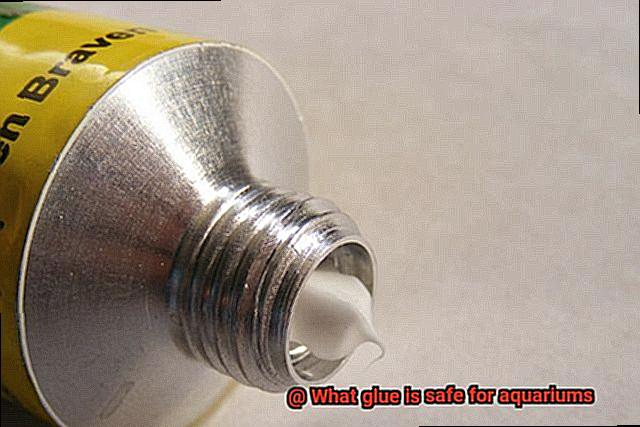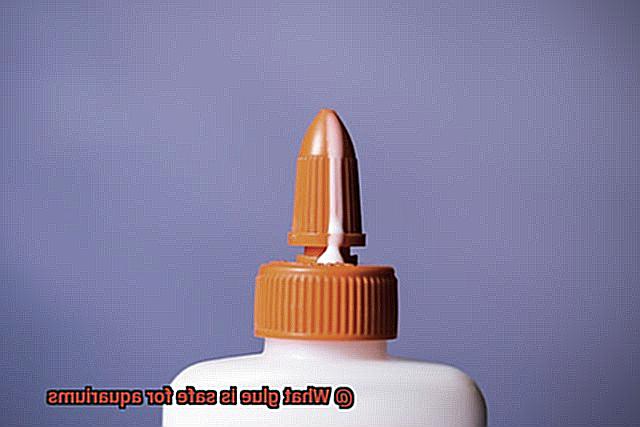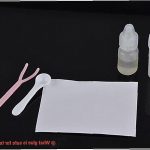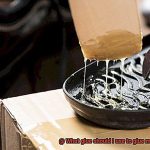Do you love your aquarium but can’t seem to find the right glue to keep everything together? Don’t fret. It’s important to choose an adhesive that not only keeps your underwater world intact but is also safe for your aquatic pets. Luckily, there are plenty of options that will do just that.
When it comes to aquarium-safe glue, there are a few key factors to consider. Firstly, avoid any adhesive that contains toxic chemicals as they can be harmful if they leach into the water. Additionally, make sure the glue is waterproof and won’t break down over time; otherwise, your carefully crafted aquascape could quickly fall apart.
Thankfully, there are several excellent options for aquarium-safe glue, including silicone, cyanoacrylate, and epoxy. Each of these has its unique benefits and is suitable for different types of applications. For instance, silicone works great for sealing leaks or attaching background decorations while cyanoacrylate is perfect for gluing rocks or coral together.
Ultimately, choosing the right aquarium-safe glue ensures your aquatic pets’ health and vitality while keeping your aquarium looking stunning. In this blog post, we’ll explore the most suitable options for aquarium-safe glue and what to look out for when making your selection. So strap on your scuba gear and let’s dive into the world of aquarium adhesives.
Types of Glue Safe for Aquariums
Contents
- 1 Types of Glue Safe for Aquariums
- 2 Silicone Sealant: The Most Commonly Used Glue in Aquariums
- 3 Epoxy: A Two-Part Adhesive for Creating a Natural Environment
- 4 Cyanoacrylate-Based Adhesives (Superglues): Quick Drying and Strong Bonding
- 5 Not All Superglues are Safe for Aquariums
- 6 Proper Application Techniques for Using Aquarium Glue
- 7 Testing New Glue Before Use in Larger Areas
- 8 Benefits of Using the Right Type of Glue in an Aquarium
- 9 Conclusion
Creating a beautiful and safe environment for your aquatic pets is essential, and using the right type of glue is a crucial part of this process. There are several types of glue that are safe for aquariums, including silicone sealant, cyanoacrylate glue, epoxy, and hot melt glue (with caution).
Silicone sealant is a popular option for aquarium enthusiasts as it is waterproof and non-toxic. It can be used to seal seams or attach decorations to the tank. However, not all silicone sealants are safe for aquariums, so it’s important to choose a product specifically designed for this purpose. Some sealants may contain additives that can be harmful to your fish.
Cyanoacrylate glue, also known as super glue, is another safe option for aquariums. It dries quickly and forms a strong bond, making it ideal for attaching small decorations or repairing broken items in the tank. However, not all superglues are created equal. It’s important to choose a product that is labeled as “aquarium-safe” or “reef-safe” and free of solvents and other harmful chemicals.
Epoxy is a two-part adhesive that is also safe for aquarium use. It’s water-resistant and has excellent bonding strength, making it ideal for attaching rocks and coral to create a natural-looking environment for your aquatic pets. Epoxy resin is also durable and can be used to bond different materials such as glass, plastic, and ceramics.
Hot melt glue can also be used in aquariums but with caution. Hot melt glue should not be used to bond materials that will be exposed to high temperatures or pressure. Once it has fully hardened and cooled down before being submerged in water, it should be safe for use in an aquarium.
When using any type of glue in an aquarium, it’s important to follow the manufacturer’s instructions carefully and allow sufficient time for the adhesive to dry before adding water or placing animals in the tank. It’s also recommended to test any new glue on a small area before using it on a larger scale.
In conclusion, using the right type of glue is essential for maintaining a safe and healthy environment for your aquatic pets. Always choose a glue that is specifically labeled as safe for aquariums and follow proper application techniques for best results.
Silicone Sealant: The Most Commonly Used Glue in Aquariums
The answer lies in silicone sealant – the most commonly used glue in aquariums. Its waterproof and non-toxic properties make it the go-to choice for sealing aquariums and ensuring the safety of aquatic life.
One of the greatest advantages of silicone sealant is that it doesn’t contain any harmful chemicals that can leach into the water and harm aquatic creatures. Made from a type of polymer called silicone, this adhesive does not release any fumes or chemicals when exposed to water. What’s more, it’s highly resistant to UV light, which means it won’t degrade or break down over time when exposed to sunlight.
Silicone sealant is also incredibly easy to apply and smooth out using a caulking gun and a smoothing tool. This allows for precise application and creates a seamless seal around the edges of the aquarium. Plus, it’s relatively inexpensive and readily available at most hardware stores and online retailers.
It’s important to note that not all silicone sealants are suitable for use in aquariums. It’s recommended to use 100% silicone sealant without any additives or mold inhibitors, as these can be harmful to aquatic life. Additionally, you must allow the sealant to cure completely before adding any water or fish to the aquarium, as uncured silicone can release harmful chemicals.
Epoxy: A Two-Part Adhesive for Creating a Natural Environment
Epoxy, the two-part adhesive, is the perfect solution for building a natural environment in your aquarium. This versatile adhesive is revolutionizing the aquarium industry as it offers many benefits that make it an ideal choice for creating a safe and healthy environment for your aquatic friends.
One of the most significant advantages of using epoxy in aquariums is its safety. Unlike other adhesives, epoxy does not contain any harmful solvents or toxins that can leach into the water and harm the fish or other aquatic animals. This means that you can use epoxy with confidence, knowing that it won’t harm your aquatic friends.
Epoxy is also incredibly versatile as it can bond a variety of materials such as glass, plastic, and ceramic. It can be used to create complex structures such as rock formations, caves, and other decorative elements that resemble the natural habitat of fish and other aquatic animals. With epoxy’s ability to mimic these natural environments, your aquatic friends will feel right at home.
Another benefit of using epoxy in aquariums is its ability to cure underwater. This means that it can be applied directly to surfaces that are submerged in water, making it ideal for use in aquariums where access to dry surfaces may be limited. It allows for easy application and ensures that the adhesive doesn’t break down or deteriorate over time.
Epoxy creates a strong bond between different materials making it an excellent choice for creating complex structures such as rock formations, caves, and other decorative elements. This ensures that everything stays in place and doesn’t collapse over time.
Using epoxy in your aquarium is a cost-effective and straightforward way to create a natural environment for your aquatic friends. By mimicking their natural habitat, you can promote their health and well-being while also creating a beautiful and engaging display in your home.
Cyanoacrylate-Based Adhesives (Superglues): Quick Drying and Strong Bonding
Look no further than cyanoacrylate-based adhesives, also known as superglues, for quick-drying and strong bonding properties. As an expert in this field, let me tell you why these adhesives are so popular among aquarium hobbyists.
One of the most significant advantages of using cyanoacrylate-based adhesives is their ability to create a secure hold that won’t weaken over time. This feature is essential when creating underwater landscapes or attaching decorations to the tank walls. You want an adhesive that can withstand the constant movement and pressure of the water without breaking down.

Furthermore, superglues have a low toxicity level and do not release harmful chemicals into the water. However, it’s important to choose a brand specifically designed for aquarium use to avoid any additives that could be harmful to aquatic life.
In addition to their strength and safety, cyanoacrylate-based adhesives are also incredibly convenient due to their quick-drying property. You won’t have to wait long for the adhesive to set and create a strong bond between materials. This feature is especially useful when working with delicate or intricate structures in your aquarium.
It’s crucial to note that proper usage is key when using these adhesives in an aquarium. Always follow the manufacturer’s instructions carefully and test the adhesive on a small area before applying it to the entire tank. This step will help ensure that the adhesive does not cause any adverse reactions with the water or aquatic life.
Not All Superglues are Safe for Aquariums
When it comes to using glue in your aquarium, it’s essential to understand that not all superglues are safe for aquariums. Some contain harmful chemicals that can be toxic to your fish and other aquatic life, making it crucial to use only aquarium-safe glue.
One of the most commonly used glues in aquariums is cyanoacrylate, also known as superglue. However, not all cyanoacrylate glues are aquarium-safe. It’s vital to read the label and ensure that the glue doesn’t contain any harmful additives like solvents or accelerators that can leach into the water and harm your fish.
Silicone-based sealant is another popular choice for sealing joints and seams in the aquarium. However, ensure that the sealant is 100% silicone and free from any harmful additives like fungicides or mildewcides.
It’s crucial to note that some glues may be safe for use outside of the water but can become toxic once submerged. This is why it’s essential to use only aquarium-safe glue specifically formulated for use in aquariums.
In summary, not all superglues are safe for use in aquariums, and it’s vital to read labels carefully and use only aquarium-safe glue when working on any projects within your tank. Here are some key takeaways:
- Cyanoacrylate glue is commonly used in aquariums but not all are safe for aquatic life
- Silicone-based sealants are ideal for sealing joints and seams, but ensure they’re free from any harmful additives
- Only use aquarium-safe glue specifically formulated for use in aquariums
- Always prioritize the health of your aquatic pets by creating a safe and healthy environment within your tank.

Proper Application Techniques for Using Aquarium Glue
It’s important to know the proper application techniques to ensure that the glue is safe for your aquatic pets and the overall health of the tank. As an expert in this field, I’ll guide you through the process of using aquarium glue safely and effectively.
Choosing the right type of aquarium glue is the first step in this process. You can find several types of aquarium glues in the market such as silicone, cyanoacrylate, and epoxy. Make sure to read labels carefully and choose only aquarium-safe glue formulated for use in tanks. This guarantees that your pets won’t be harmed by any toxic substances.
After selecting the appropriate glue, preparing the surface correctly is key to ensuring a successful bond. Thoroughly clean and dry the surface before applying any glue. Any dirt or debris on the surface can compromise the adhesive properties of the glue, leading to potential failure and harm to your aquarium inhabitants.
When applying aquarium glue, it’s best to use it in small amounts at a time and work in sections. This approach allows for better control over the application, preventing excess glue from getting into the water and potentially harming your pets. Avoid applying too much pressure when bonding objects together, as this can cause stress on the glass or acrylic surfaces of the aquarium.
Once you’ve applied the glue, it’s crucial to allow it to cure completely before adding any water or fish back into the tank. The curing time will vary depending on the type of glue used, so it’s essential to follow the manufacturer’s instructions precisely. Rushing this step can result in a weak bond that could fail and harm your pets.
Testing New Glue Before Use in Larger Areas

Using the wrong glue can be disastrous, causing harm to your beloved fish and other inhabitants. That’s why it is crucial to test any new glue before using it extensively in larger areas of your aquarium.
But why is testing new glue so important? Let’s explore some reasons:
Firstly, testing new glue ensures the safety of your aquarium inhabitants. By applying a small amount of glue to a non-visible area, like the underside of a rock or behind a plant, you can check if the glue is safe for the aquarium environment and won’t harm your pets. Some types of glue can release toxic substances into the water, which can affect aquatic life and harm your fish. Testing before use helps you avoid using toxic or harmful glues.
Secondly, testing new glue checks bond strength and longevity. By observing the glue over several days, you can check if it holds up over time and provides a strong bond. This will give you an idea of how well it will work in larger areas of your aquarium.
Lastly, testing new glue prevents discoloration or changes in water quality that may occur due to certain types of glues. By testing on a non-visible area first, you can avoid any discoloration or changes that may be unsightly or harmful to your aquarium inhabitants.
It’s important to choose a safe and appropriate type of adhesive for aquarium use. Some commonly used types of glue in aquariums include silicone sealant, epoxy resin, and cyanoacrylate (super glue). Each type has its specific strengths and weaknesses, so make sure to choose the right one for your needs.
To test the glue, apply a small amount to a non-visible area as mentioned earlier. Allow it to dry completely and observe the area for any changes in water quality or discoloration over several days. If there are no adverse effects, then it is safe to use the glue in larger areas.
Benefits of Using the Right Type of Glue in an Aquarium
It’s crucial to understand the importance of using the right type of glue. As an expert on this topic, I am here to explain why selecting the correct adhesive is a significant consideration when setting up your tank.
First and foremost, using a reliable and safe adhesive can prevent leaks and ensure that your aquarium is watertight, which is especially vital for larger tanks that hold substantial amounts of water. A leak can cause damage to your aquarium and harm the aquatic life inside it. Therefore, using the right type of glue can avoid potential disasters and keep your aquatic pets safe.
Another essential factor to consider is that some types of glue may contain harmful chemicals that can leach into the water and harm your fish or other aquatic creatures. By using a glue specially designed for aquarium use, you can rest assured that it won’t introduce any toxic substances into the water.
Moreover, using the right type of glue can enhance the aesthetic appeal of your aquarium. By utilizing a clear and seamless adhesive, you can create a natural look by joining different materials such as rocks, wood, and plants without being noticeable. Additionally, you can get creative with your designs by creating tunnels or caves for your fish to swim through.
Lastly, investing in a reliable aquarium-safe glue can save you money in the long run by reducing the need for repairs or replacements due to leaks or inadequate adhesive properties. By investing in high-quality adhesive upfront, you’ll avoid costly repairs down the line.
dMrqgq_JtdY” >
Conclusion
In summary, selecting the appropriate glue for your aquarium is a crucial step in maintaining a safe and healthy environment for your aquatic friends. Toxic chemicals must be avoided at all costs, and the adhesive must be waterproof and resistant to deterioration over time. Fortunately, there are numerous options available for aquarium-safe glue, including silicone sealant, cyanoacrylate glue, epoxy, and hot melt glue (with caution).
Silicone sealant is the most popular choice due to its ability to resist water and its non-toxic properties. Cyanoacrylate-based adhesives are ideal for fast-drying and strong bonding capabilities, while epoxy is perfect for creating a natural-looking environment in your tank. However, it’s critical to choose only aquarium-safe glues that have been specifically formulated for use in tanks.
When using aquarium glue, proper application techniques are also essential. Thoroughly cleaning and drying the surface before applying any adhesive will ensure a successful bond. Additionally, testing new glue before using it extensively in larger areas can prevent harm to your beloved fish and other inhabitants.
Using the correct type of adhesive can prevent leaks, enhance aesthetic appeal, save you money on repairs or replacements, and most importantly keep your aquatic pets safe.






